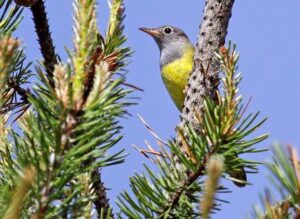UNDERSTANDING DECLINES IN CONNECTICUT WARBLERS
Presented by Dr. Michael Hallworth, Vermont Center for Ecostudies

Connecticut Warbler (photo credit: Ryan Brady)
The Connecticut Warbler is a long-distance, migratory songbird whose populations have declined over 60% rangewide and nearly 70% in Bird Conservation Region 12 since 1966, leading Partners in Flight, the Northern Forest Bird Network, and other conservation planners to list it as a high priority species. Factors driving these declines are poorly understood, however, and may be occurring on boreal forest breeding grounds, wintering areas in South American lowlands, and/or migratory routes along the way.
In this presentation and discussion session, Dr. Michael Hallworth of the Vermont Center for Ecostudies will present results of his recent work to elucidate factors behind the Connecticut Warbler’s mysterious decline. Hallworth and co-authors integrated data collected from tracking technology, community science, and remote sensing to quantify migratory connectivity, population trends, and habitat loss, discovering that habitat loss on the breeding grounds may be the primary cause for declines.
Did this result hold for Connecticut Warbler populations in Minnesota, Wisconsin, and Michigan? What land-use practices would benefit the species here? How else can we benefit Connecticut Warblers during their annual life cycles? Find answers to these questions and more in this special session hosted by Wisconsin DNR & the Northern Forest Bird Network.
You can watch the recording of this presentation and subsequent discussion here:


